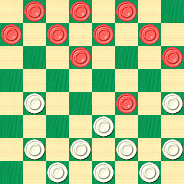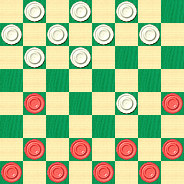The Checker Maven
Jump to navigationA Leak in the Dyke

In 1931, the great checkerist Louis C. Ginsberg wrote what may be his only book on checkers, a little booklet called Principles of Strategy in the Game of Checkers. It was later reprinted by William Ryan, with the addition of an informative and highly entertaining introduction.
Principles of Strategy appears to have been the prototype for other similar booklets which never got written, although we can't be quite sure about this. Principles of Strategy, while mentioning the existence of numerous other characteristic formations in the game of checkers, deals exclusively with what are known as "Dyke" formations.
The booklet is a real gem and a welcome addition to the library of any checkerist; it is especially useful at the early intermediate stage of development. In conjunction with Bob Murr's PDN file of the examples contained in this work (see link in the column to the right), today we'll present the full text of two of these examples. Pay close attention to the Example 15 below, as it will help you solve the problem we pose later.
"DYKE" FORMATIONS---EXAMPLE 15
9-13 24-20
11-15 22-17
13-22 25-11
8-15 21-17
4-8 29-25
15-19-A 23-16
12-19 27-23
8-12 23-16
12-19 17-13-B
10-15-C 20-16
6-1-D Drawn

WHITE
Position at Note A, White to Move
A---This illustration is given to show when Black can place a piece on 19 with apparently only two pieces in reserve for the defense of the man. There must be a White man on 17.
B---White must remove the man from 17 before going 32-27 to attack the man on 19.
C---Black gains a move, an idea that is utilized in many different games, due to the White man being located on 17. If there was no White man on 17, the man on 19 would be lost to Black by the runoff via 27-23.
Get the idea? Now let's look at a Dyke example that arises in the Single Corner opening:

BLACK
Dyke Position with Black to Play
11-15 22-18
15-22 25-18
12-16 29-25
9-13 18-14
10-17 21-14 (diagram above)
16-20 24-19
6-10 25-21
10-17 21-14
2-6 30-25
6-10 25-21
10-17 21-14
1-6 Black Wins.
The White "Dyke" man on 14 is lost as there is no defense against Black's next move, 6-10.
What went wrong here? We've left it to you to find the leak in this Dyke. Can you find White's losing move and correct it? Click on Read More when you have your answer.![]()
Let's look at this situation as Mr. Ginsberg originally published it:
"DYKE" FORMATIONS---EXAMPLE 16
11-15 22-18
15-22 25-18
12-16 29-25
9-13 18-14-A
10-17 21-14
16-20-B 23-18-C
6-10 25-21
10-17 21-14
1-6-D 26-23
13-17 31-26 Etc. Drawn
A---Another illustration of commanding square 14 with apparently only two pieces in reserve, as in Example 15.
B---Forcing 23-18 or 25-21, for if 24-19 White loses the man by 6-10 and running it off three times.
C---Gaining a move in the development while the piece is removed from 16, as in the counterpart in Example 15.
D---If 13-17, 24-19 (not 26-23, as Black goes 17-22), 1-6, 27-23, and later 31-27, getting the game back in the trunk.
So now we see what White should have played instead of the losing 24-19 (at note B). 23-18 is probably a little stronger but 25-21 is fine. After 23-18, 6-10 won't work as White plays 25-21 and 10-17 21-14 follows. Now if Black tries 2-6 then 26-23 and 6-10? is a mistake punished by 14-9 5-14 18-9 and White has a bit of an edge.
Again going back to Note B, observe that Black can't immediately play 1-6 as White can simply respond with the slip 24-19, picking off the exposed man on 16.
You can email the Webmaster with comments on this article.
